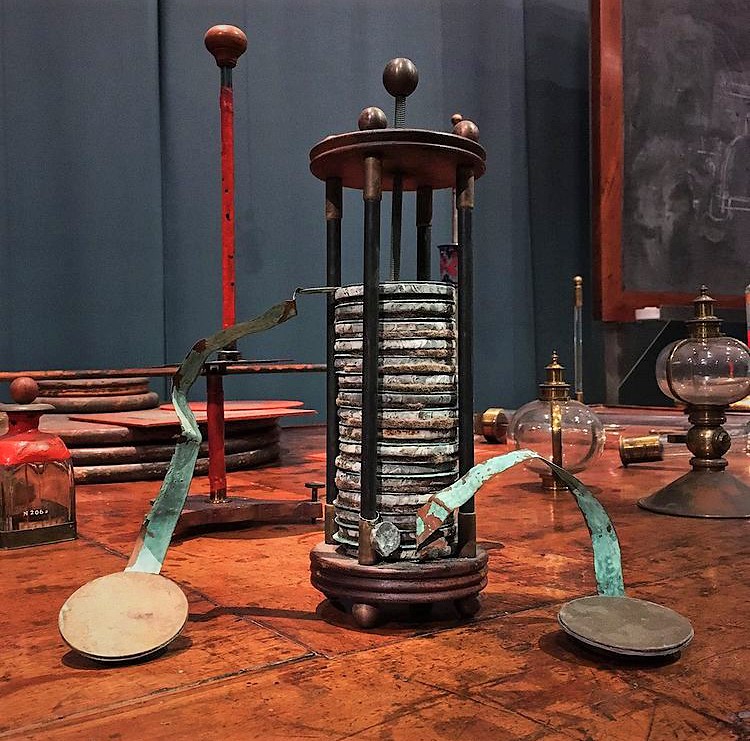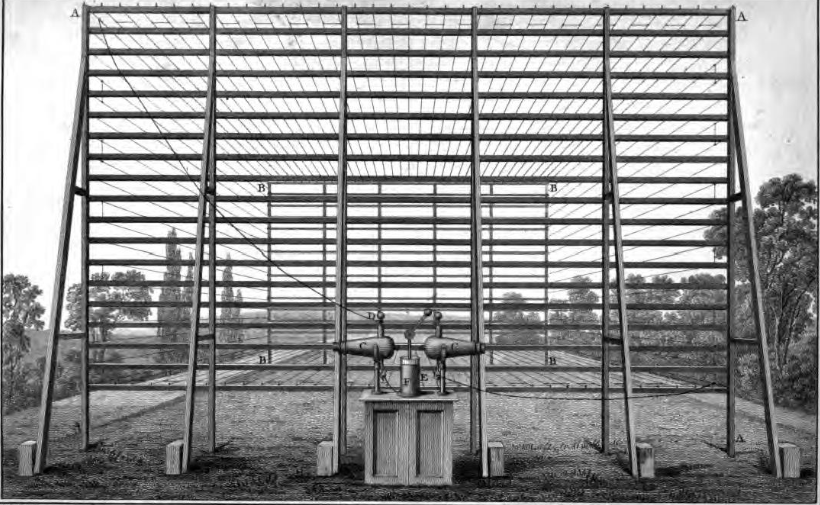|
Ohm's Law
Ohm's law states that the current through a conductor between two points is directly proportional to the voltage across the two points. Introducing the constant of proportionality, the resistance, one arrives at the usual mathematical equation that describes this relationship: :I = \frac, where is the current through the conductor, ''V'' is the voltage measured ''across'' the conductor and ''R'' is the resistance of the conductor. More specifically, Ohm's law states that the ''R'' in this relation is constant, independent of the current. If the resistance is not constant, the previous equation cannot be called ''Ohm's law'', but it can still be used as a definition of static/DC resistance. Ohm's law is an empirical relation which accurately describes the conductivity of the vast majority of electrically conductive materials over many orders of magnitude of current. However some materials do not obey Ohm's law; these are called non-ohmic. The law was named after ... [...More Info...] [...Related Items...] OR: [Wikipedia] [Google] [Baidu] |
Gustav Kirchhoff
Gustav Robert Kirchhoff (; 12 March 1824 – 17 October 1887) was a German physicist who contributed to the fundamental understanding of electrical circuits, spectroscopy, and the emission of black-body radiation by heated objects. He coined the term black-body radiation in 1862. Several different sets of concepts are named "Kirchhoff's laws" after him, concerning such diverse subjects as black-body radiation and spectroscopy, electrical circuits, and thermochemistry. The Bunsen–Kirchhoff Award for spectroscopy is named after him and his colleague, Robert Bunsen. Life and work Gustav Kirchhoff was born on 12 March 1824 in Königsberg, Prussia, the son of Friedrich Kirchhoff, a lawyer, and Johanna Henriette Wittke. His family were Lutherans in the Evangelical Church of Prussia. He graduated from the Albertus University of Königsberg in 1847 where he attended the mathematico-physical seminar directed by Carl Gustav Jacob Jacobi, Franz Ernst Neumann and Fried ... [...More Info...] [...Related Items...] OR: [Wikipedia] [Google] [Baidu] |
Electromotive Force
In electromagnetism and electronics, electromotive force (also electromotance, abbreviated emf, denoted \mathcal or ) is an energy transfer to an electric circuit per unit of electric charge, measured in volts. Devices called electrical '' transducers'' provide an emf by converting other forms of energy into electrical energy. Other electrical equipment also produce an emf, such as batteries, which convert chemical energy, and generators, which convert mechanical energy. This energy conversion is achieved by physical forces applying physical work on electric charges. However, electromotive force itself is not a physical force, and for the current ISO/IEC standards consider the term deprecated, favoring the names source voltage or source tension instead (denoted U_s). An electronic–hydraulic analogy may view emf as the mechanical work done to water by a pump, which results in a pressure difference (analogous to voltage). In electromagnetic induction, emf can be defi ... [...More Info...] [...Related Items...] OR: [Wikipedia] [Google] [Baidu] |
Internal Resistance Model
{{disambig ...
Internal may refer to: * Internality as a concept in behavioural economics * Neijia, internal styles of Chinese martial arts * Neigong or "internal skills", a type of exercise in meditation associated with Daoism *'' Internal (album)'' by Safia, 2016 See also * * Internals (other) *External (other) External may refer to: * External (mathematics), a concept in abstract algebra * Externality In economics, an externality or external cost is an indirect cost or benefit to an uninvolved third party that arises as an effect of another party' ... [...More Info...] [...Related Items...] OR: [Wikipedia] [Google] [Baidu] |
Galvanometer
A galvanometer is an electromechanical measuring instrument for electric current. Early galvanometers were uncalibrated, but improved versions, called ammeters, were calibrated and could measure the flow of current more precisely. A galvanometer works by deflecting a pointer in response to an electric current flowing through a coil in a constant magnetic field. Galvanometers can be thought of as a kind of actuator. Galvanometers came from the observation, first noted by Hans Christian Ørsted in 1820, that a magnetic compass's needle deflects when near a wire having electric current. They were the first instruments used to detect and measure small amounts of current. André-Marie Ampère, who gave mathematical expression to Ørsted's discovery, named the instrument after the Italian electricity researcher Luigi Galvani, who in 1791 discovered the principle of the frog galvanoscope – that electric current would make the legs of a dead frog jerk. Galvanometers have been ... [...More Info...] [...Related Items...] OR: [Wikipedia] [Google] [Baidu] |
Thermocouple
A thermocouple, also known as a "thermoelectrical thermometer", is an electrical device consisting of two dissimilar electrical conductors forming an electrical junction. A thermocouple produces a temperature-dependent voltage as a result of the Seebeck effect, and this voltage can be interpreted to measure temperature. Thermocouples are widely used as temperature sensors. Commercial thermocouples are inexpensive, interchangeable, are supplied with standard connectors, and can measure a wide range of temperatures. In contrast to most other methods of temperature measurement, thermocouples are self powered and require no external form of excitation. The main limitation with thermocouples is accuracy; system errors of less than one degree Celsius (°C) can be difficult to achieve. Thermocouples are widely used in science and industry. Applications include temperature measurement for kilns, gas turbine exhaust, diesel engines, and other industrial processes. Thermocouples are ... [...More Info...] [...Related Items...] OR: [Wikipedia] [Google] [Baidu] |
Voltaic Pile
upright=1.2, Schematic diagram of a copper–zinc voltaic pile. The copper and zinc discs were separated by cardboard or felt spacers soaked in salt water (the electrolyte). Volta's original piles contained an additional zinc disk at the bottom, and an additional copper disk at the top. These were later shown to be unnecessary file:VoltaBattery.JPG, upA voltaic pile on display in the ''Tempio Voltiano'' (the Volta Temple) near Volta's home in Como, Italy The voltaic pile was the first electrical battery that could continuously provide an electric current to a circuit. It was invented by Italian chemist Alessandro Volta, who published his experiments in 1799. The voltaic pile then enabled a rapid series of other discoveries including the electrical decomposition (electrolysis) of water into oxygen and hydrogen by William Nicholson and Anthony Carlisle (1800) and the discovery or isolation of the chemical elements sodium (1807), potassium (1807), calcium (1808), boron (1808), b ... [...More Info...] [...Related Items...] OR: [Wikipedia] [Google] [Baidu] |
Joseph Fourier
Jean-Baptiste Joseph Fourier (; ; 21 March 1768 – 16 May 1830) was a French mathematician and physicist born in Auxerre and best known for initiating the investigation of Fourier series, which eventually developed into Fourier analysis and harmonic analysis, and their applications to problems of heat transfer and vibrations. The Fourier transform and Fourier's law of conduction are also named in his honour. Fourier is also generally credited with the discovery of the greenhouse effect. Biography Fourier was born at Auxerre (now in the Yonne département of France), the son of a tailor. He was orphaned at the age of nine. Fourier was recommended to the Bishop of Auxerre and, through this introduction, he was educated by the Benedictine Order of the Convent of St. Mark. The commissions in the scientific corps of the army were reserved for those of good birth, and being thus ineligible, he accepted a military lectureship on mathematics. He took a prominent part in his own di ... [...More Info...] [...Related Items...] OR: [Wikipedia] [Google] [Baidu] |
Electrometer
An electrometer is an electrical instrument for measuring electric charge or electrical potential difference. There are many different types, ranging from historical handmade mechanical instruments to high-precision electronic devices. Modern electrometers based on vacuum tube or solid-state technology can be used to make voltage and charge measurements with very low leakage currents, down to 1 femtoampere. A simpler but related instrument, the electroscope, works on similar principles but only indicates the relative magnitudes of voltages or charges. Historical electrometers Gold-leaf electroscope The gold-leaf electroscope was one of the instruments used to indicate electric charge. It is still used for science demonstrations but has been superseded in most applications by electronic measuring instruments. The instrument consists of two thin leaves of gold foil suspended from an electrode. When the electrode is charged by induction or by contact, the leaves acquire s ... [...More Info...] [...Related Items...] OR: [Wikipedia] [Google] [Baidu] |
Voltaic Pile
upright=1.2, Schematic diagram of a copper–zinc voltaic pile. The copper and zinc discs were separated by cardboard or felt spacers soaked in salt water (the electrolyte). Volta's original piles contained an additional zinc disk at the bottom, and an additional copper disk at the top. These were later shown to be unnecessary file:VoltaBattery.JPG, upA voltaic pile on display in the ''Tempio Voltiano'' (the Volta Temple) near Volta's home in Como, Italy The voltaic pile was the first electrical battery that could continuously provide an electric current to a circuit. It was invented by Italian chemist Alessandro Volta, who published his experiments in 1799. The voltaic pile then enabled a rapid series of other discoveries including the electrical decomposition (electrolysis) of water into oxygen and hydrogen by William Nicholson and Anthony Carlisle (1800) and the discovery or isolation of the chemical elements sodium (1807), potassium (1807), calcium (1808), boron (1808), b ... [...More Info...] [...Related Items...] OR: [Wikipedia] [Google] [Baidu] |
Francis Ronalds
Sir Francis Ronalds FRS (21 February 17888 August 1873) was an English scientist and inventor, and arguably the first electrical engineer. He was knighted for creating the first working electric telegraph over a substantial distance. In 1816 he laid an eight-mile length of iron wire between wooden frames in his mother's garden and sent pulses using electrostatic generators. Upbringing and family Born to Francis Ronalds and Jane (née Field), wholesale cheesemongers, at their business premises in Upper Thames Street, London, he attended Unitarian minister Eliezer Cogan's school before being apprenticed to his father at the age of 14 through the Drapers' Company. He ran the large business for some years. The family later resided in Canonbury Place and Highbury Terrace, both in Islington, at Kelmscott House in Hammersmith, Queen Square in Bloomsbury, at Croydon, and on Chiswick Lane. Several of Ronalds' eleven brothers and sisters also led noteworthy lives. His youngest ... [...More Info...] [...Related Items...] OR: [Wikipedia] [Google] [Baidu] |
James Clerk Maxwell
James Clerk Maxwell (13 June 1831 – 5 November 1879) was a Scottish mathematician and scientist responsible for the classical theory of electromagnetic radiation, which was the first theory to describe electricity, magnetism and light as different manifestations of the same phenomenon. Maxwell's equations for electromagnetism have been called the " second great unification in physics" where the first one had been realised by Isaac Newton. With the publication of "A Dynamical Theory of the Electromagnetic Field" in 1865, Maxwell demonstrated that electric and magnetic fields travel through space as waves moving at the speed of light. He proposed that light is an undulation in the same medium that is the cause of electric and magnetic phenomena. (This article accompanied an 8 December 1864 presentation by Maxwell to the Royal Society. His statement that "light and magnetism are affections of the same substance" is at page 499.) The unification of light and elec ... [...More Info...] [...Related Items...] OR: [Wikipedia] [Google] [Baidu] |




.jpg)


